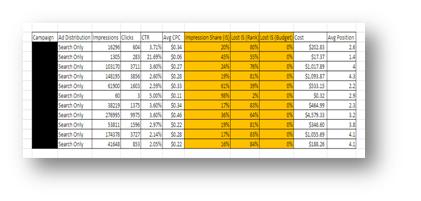Google initially introduced their impression share reporting to AdWords advertisers back in April. To be perfectly honest, there was little buzz within the industry, and this advertiser (yes, me) didn’t pay much attention. After speaking with our AdWords rep, the team here at PPC Hero discovered that the impression share report was receiving some additional data: lost impression share by rank and budget. Well, I may have ignored this little gem once, but this time I’ve got impression share square in my sights (insert “fool me once” quip here).
To kick things off, let’s cover what the original impression share (IS) report was all about:
“Impression share is a new AdWords metric that represents the percentage of impressions where your ads were shown out of the total available impressions in the market you were targeting. This metric is available at the campaign and account level for search.”
Running the IS report at the account level will do just that: give you the percentage of impressions shown in the total market. At the campaign level, this information becomes a bit convoluted. Google considers whether you have multiple campaigns which target the same market. From this, the IS distributes accordingly between those campaigns compared to the total market.
When it comes to managing your PPC accounts, knowing which campaigns are “co-competing” within your account is an invaluable piece of information. From this data point, you can then make educated decisions on which campaign should receive budget increases or intensified management (bids, ads, et. al.).
Thankfully, this brings me back to the breaking news. Google has taken IS reporting to the next level by including data for lost IS by rank and budget. What they mean by “rank” is of course those factors contributing to your Ad Rank (cost-per-click bid X Quality Score). Truthfully, this data is Google bridging the mathematical gap for those missing the obvious implications. If you had a 20% IS, then you lost 80% IS. This metric is important however, because Google is attaching it to a certain set of PPC management objectives (Quality Score!).
Budget is fairly obvious – do you allow your campaigns/account to spend enough money through the course of the day to remain competitive? If you’ve lost IS in this column, you simply need to raise your budget. Here’s an example of what these IS reports look like (pulled at the campaign level):

In this example you will notice that the account is in the clear for budget, so I can automatically dismiss that from my management decisions. However, this is where I need to begin examining how well my efforts are stacking up against my competitors (and myself) in regards to Ad Rank. For this client, I have a few campaigns with IS percentages in the teens. This immediately tells me that either A: I’m underbidding, or B: I’ve got outdated ads with low click-through-rates that need updating (most likely).
I will begin checking this report as I work on this client’s performance. In a few weeks I’ll drop another post to let everyone know how well this report has guided me in making positive management decisions. Has anyone else toyed with impression share reporting and used it to make account management decisions?



